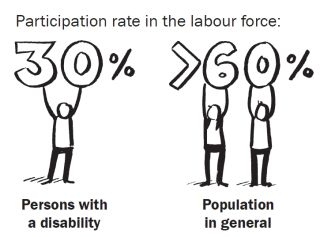Work and People with Disabilities

Results from Census 2016 provide the most recent insight into the scale and nature of disability in Ireland. In a report published in November 2017, the CSO reported that a total of 643,131 people had a disability in Ireland; equivalent to 13.5 per cent of the population. The most common disability was a difficulty with pain, breathing or other chronic illness which was experienced by 46.1 per cent of all people with a disability. This was followed by a difficulty with basic physical activities, experienced by 40.9 per cent. The report found that both these disabilities were strongly age-related. The report showed that:
- 1.2 per cent of the population were blind or had a sight related disability (54,810 people);
- 1.4 per cent of the population suffered from an intellectual disability (66,611 people);
- 2.2 per cent of the population were deaf or had a hearing related disability (103,676 people);
- 2.6 per cent of the population had a psychological or emotional condition (123,515 people);
- 3.3 per cent of the population had a difficulty with learning, remembering or concentrating (156,968 people);
- 5.5 per cent of the population had a difficulty with basic physical activities (262,818 people);
- 6.2 per cent of the population had a disability connected with pain, breathing or another chronic illness or condition (296,783 people).
The recent European Commssion country Report for Ireland 2019 revealed that Ireland has one of the lowest employment rates for people with disabilities in the EU (26.2 % compared to 48.1 % in the EU in 2017). Ireland also has one of the highest gaps between people with and without disabilities (45.1 percentage points) in employment.
A 2017 ESRI report examined the employment transitions of people with a disability and found that among those of working age most (82 per cent) had worked at some stage in their life but that 35 per cent had been without work for more than four years. It also found that were Government policy to facilitate the employment of people with a disability who want to work, some 35,600 additional people with a disability would join the active workforce; a figure equivalent to 1.5 per cent of the 2017 labour force.
This low rate of employment among people with a disability is of concern. Apart from restricting their participation in society it also ties them into state-dependent low-income situations. Therefore, it is not surprising that Ireland’s poverty figures reveal that people who are ill or have a disability are part of a group at high risk of poverty.
Social Justice Ireland believes that further efforts should be made to reduce the impediments faced by people with a disability to obtain employment.
In particular, consideration should be given to reforming the current situation in which many such people face losing their benefits, in particular their medical card, when they take up employment. This situation ignores the additional costs faced by people with a disability in pursuing their day-to-day lives. For many people with disabilities the opportunity to take up employment is denied to them and they are trapped in unemployment, poverty, or both.
Some progress was made in Budget 2005 to increase supports intended to help people with disabilities access employment. However, sufficient progress has not been made and recent Budgets have begun to reduce these services. New policies, including that outlined above, need to be adopted if this issue is to be addressed successfully. It is even more relevant today, given the growing employment challenges of the past few years.